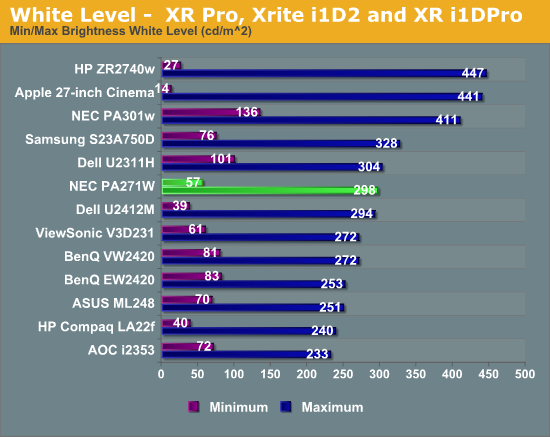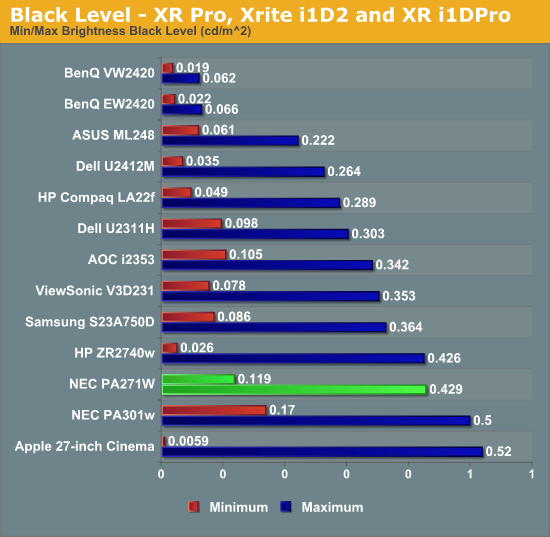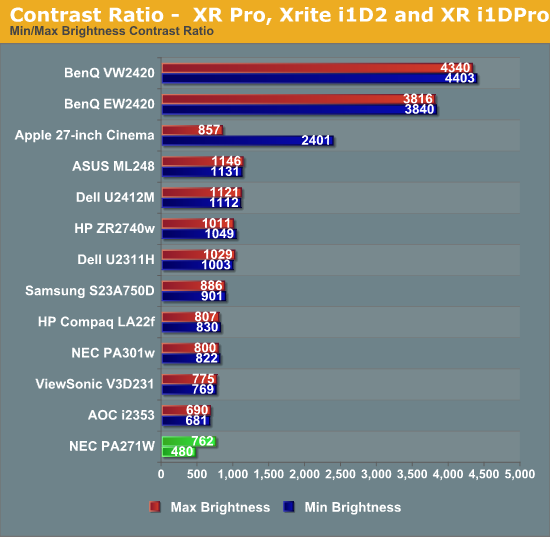NEC PA271W - When Accuracy and Consistency Matter
by Chris Heinonen on May 1, 2012 1:55 PM ESTNEC PA271W - Brightness and Contrast
The NEC is rated fairly conservatively at only 300 nits of light output at maximum, though for a professional work environment that is likely more than anyone would need. The OSD for the NEC lets you know the light output in cd/m^2 (which is equivalent to nits) as you raise and lower the value, and once you move past 250, the color changes to let you know you’re going beyond where the screen uniformity measurements can help you. Driven to the maximum output, the screen might read 400 cd/m^2 but the actual value was far less than that.

As we can see, we managed right around the maximum value of 300 nits, so that conservative estimate is right on in this case. The OSD might not indicate the correct value once you move past the recommended 250 cd/m^2 level, but below that it seemed to be within 3-4% of the listed value which was pretty good. You can see the lowest light output level was down to 57 nits, which means you can adjust the display to be dim enough for any work environment you might have.
Of course, with our accurate white levels we have to hope that we get good black levels as well, which has not been the high point for IPS screens with CCFL backlights, as opposed to LED dimming setups, in the past.

Unfortunately our black levels do leave a bit to be desired. The level at the minimum is 0.119, and I’d hope for something closer to 0.050 or less, and the maximum level was 0.429, which looks closer to a dark gray than black at that level. These indicate that our contrast ratio probably is going to leave a bit to be desired with the NEC.

As we could guess, the contrast ratio with the minimum backlight is only 480:1, and it rises up to 762:1 with the monitor at maximum output. With the wide swing between these two values I went ahead and measured the contrast ratio at our calibrated 200 nits setting and found it was 561:1, so the ratio improves as the light output level increases. It seems there is a minimum amount of light that the IPS panel is going to let through, which could be related to the screen uniformity technology used by NEC on the display, but you should be aware that if you want deep, dark blacks you’ll need to look for a different display using either a different panel technology, a different backlighting technology, or both.










69 Comments
View All Comments
JarredWalton - Tuesday, May 1, 2012 - link
Brian Klug is working on a review I believe. Stay tuned....B3an - Wednesday, May 2, 2012 - link
Next time can you or Brian in his future review mention the fact that these are 16:10 junk, instead of 16:9, and point out why this is so stupid for the area these monitors are aimed at (they should be 2560x1600 res!). Many of which will be people that work in some area of design and would benefit from extra pixels.These things are not for watching movies. For almost anything else including basic things like viewing this very web page, the extra vertical pixels are better.
ectoplasmosis - Wednesday, May 2, 2012 - link
If you're going to go on a bizarre rant, at least make sure you've got your aspect ratios the right way round.theoryzero - Tuesday, May 1, 2012 - link
NEC's page mentions "Rapid Response" or "Response Improve" feature that can be enabled using the MultiProfiler software. Does that feature help with the processing lag?Senti - Tuesday, May 1, 2012 - link
It doesn't. It enables panel overdrive. With it it becomes one of the fastest IPS panels I've seen, but you also get quite bad overdrive artifacts.weiln12 - Tuesday, May 1, 2012 - link
You mention for gaming the HP is the best bet, yet it's worse in lag than the Apple 27". From my quick perusal of the charts appeared to be worse in most categories for color reproduction and everything else.The prices don't seem that far off either based on a cursory Google search of the HP ZR2740w and Apple's given prices.
Could you mind clarifying why the HP is the best bet for gaming, is there something I'm missing?
cheinonen - Tuesday, May 1, 2012 - link
The Apple only works with Thunderbolt, so that's not going to be an option for most gamers, who still use a PC and not a Mac. The HP is incredibly close to the Apple in most numbers, and the lag measurement used for the HP is far more accurate than the one used for the Apple, so they could be closer than the charts indicate.ectoplasmosis - Wednesday, May 2, 2012 - link
The Thunderbolt version isn't the only one available.I'm using a displayport 27" Cinema Display connected to both a PC (DVI) and Mac Pro (mDP) via an mDP KVM switch. By far the best screen I've ever laid eyes on, and crystal-clear with no horrible murky anti-glare coating like almost every other 2560x1440 27" screen.
AeroWB - Wednesday, May 2, 2012 - link
The high gloss display of Apple screen may look fancy and give more punch to the colors, but it can be extremely annoying depending on the room lighting and even in a medium lit room high gloss displays are extremely bad when displaying dark content, as you will see your own reflexion more clearly then the content being displayed.Glossy displays do work well in very dark rooms, but I doubt it is good to work in a dark room and stare into a big light. I do not think it is a coincidence that all professional displays and laptops are non-gloss and in general getting a non-gloss display is the safer option. If color is important glossy screens are a very bad option even if you're careful with the room lighting. it seems to me gloss is so prevalent in the consumer space as it is cheaper to built and looks fancier when displaying bright content. Though it must be said those non-glare coatings do have some influence on the brightness and sharpness of the display though after using my PA241W for about a year I am very happy I did not get the glossy Apple display (which a friend of mine has)
ectoplasmosis - Wednesday, May 2, 2012 - link
The room my ACD's in is far from dark, but is arranged so that screen reflections are a complete non-issue, even with darker content.If you've got control over your environment and lighting then a glossy screen, like you say, gives better contrast, saturation and colour accuracy than an equivalent panel with fuzzy anti-glare coating.
I know which one I prefer, and it's not about looking "fancy" in the least.